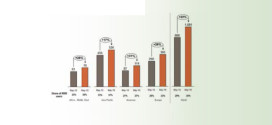In 2010, the gtnews Treasury Risk survey tracked the challenges that corporates faced in mitigating risk and popular risk management methods. Th e results showed that concerns over liquidity remained high on the corporate agenda.
Six hundred and one corporates took part in the research, providing a comprehensive set of results. Respondents came from a cross-section of companies and sizes.
The survey said, “For the fi rst few years of this century, cheap liquidity was easy to come by if you were at a company with good credit ratings – whether this was through bonds, commercial paper, notes or uncommitted bank facilities. Th e credit crisis had the eff ect of abruptly cutting off many of these options, with costs also spiralling. So a couple of years aft er the credit crisis hit, gtnews was keen to understand just how easy it was now for corporates to access liquidity. Th e results showed a rather mixed picture.
“Forty-two percent of organisations reported that it was easier to access liquidity currently compared to 12 months previously. Another 28 per cent noticed no change in access to liquidity, while the remaining 30 per cent considered it more diffi cult to access liquidity than 12 months ago…
“Overall, there is a slight trend towards liquidity being easier to access for some corporates, but these results also show that corporates still face a struggle to access liquidity and the conditions that existed before the credit crisis remain a distant memory for most. It is likely that corporates are experiencing a variety of diff erent conditions from banks that they are striking up new relationships with in the eff ort to manage counterparty risk.”
Th e 2010 Treasury Risk Survey also sought to fi nd out the level to which fi rms had changed their treasury structure over the past year, if at all, in order to manage liquidity risk.
Fift y-two percent of respondents had not changed their structures, leaving nearly half of all respondents making some change to their treasury set-up. One-third said that they had made changes as a result of liquidity risk – 28 per cent becoming more centralised and fi ve per cent becoming fully centralised. Another 11 per cent of respondents made changes to their treasury operations unrelated to the liquidity risk they faced.
 Cash And Trade Magazine For Cash and Trade professionals in the Middle East
Cash And Trade Magazine For Cash and Trade professionals in the Middle East




